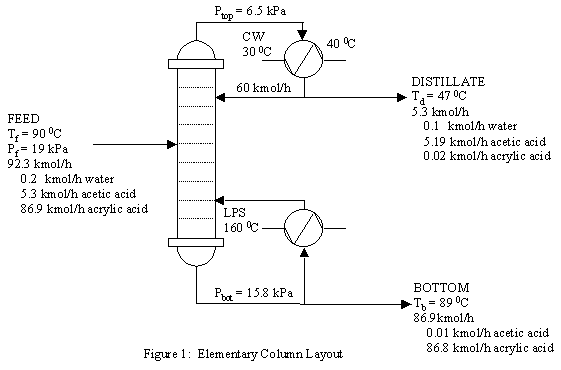| Energy Conservation in Distillation |
Energy Conservation in Distillation
The preferred method of separation
in the chemical industry, distillation, is a very energy intensive process.
Fine tuning your distillation columns (and in some cases, making major changes)
can save your company thousands of dollars a year or more. Consider the
following distillation column:

Column Design Specifications
| Feed Temperature (0C) |
90.0 |
| Feed Pressure (kPa) |
19.0 |
| Top Pressure (kPa) |
6.5 |
| Bottom Pressure (kPa) |
15.8 |
| Reflux Ratio |
12.2 |
| R/Rmin |
1.18 |
| Feed Stage |
9 |
| Number of Actual Trays |
31 |
| Tray Efficiency |
78% |
| Diameter (m) |
1.2 |
| Length (m) |
22 |
| Flooding |
53% |
| Condenser Heat Duty
(MJ/h) |
-2726 |
| Reboiler Heat Duty (MJ/h) |
2679 |
| Acrylic Acid Purity |
99.9% |
We'll examine this column and with
some help from the
Tower Pricing and Sizing
Add-In, we'll see how small changes can save you money in energy costs.
Check product purity (Rating: Minimal or No
Investment)
Many companies tend to excessively purify products and
sometimes with good reason. However, purifying to 98% when 95% is
acceptable is just not necessary. In this case, the reflux rate should be
decreased in small increments until the desired purity is obtained. In our
example, the current reboiler duty will require $68,000 in low pressure steam
per year. However, if the purity is decreased and the duty in the reboiler
decreases by 5% (down to 2545 MJ/h), the cost of steam decreases to $64,500.
Summary:
Excess purification was causing increased spending in
the amount of $3,500 per year in the reboiler alone.
Seasonal Operating Pressure Adjustments (Rating:
Minimal or No Investment)
For plants that are in locations that experience winter
climates, the operating pressure can be reduced according to a decrease in
cooling water temperatures. Although lowering the pressure in our column
would actually be an expense since it's under vacuum, this would not always
be the case. The lower pressure will facilitate separation thus lowering
energy consumption.
Summary:
Take advantage of lower temperatures outside
Upgrading Column Internals (Rating: Moderate
Investment)
Damaged or worn internals can turn your distillation column
into a money pit. As the internals become damaged, efficiency decreases and
pressure drops rise. This causes the column to run at a higher reflux rate over
time. With an increased reflux rate, energy costs will increase accordingly.
Replacing the trays with new ones or adding a high performance packing can have
the column operating like the day it was brought online.
Summary:
If operating conditions have seriously deviated from
designed operating conditions, this moderate investment can be well worth the
price tag in the long run.
Improved Heat Integration (Rating: High Investment)
In many cases, the overhead product can be used to preheat the
feed stream of distillation columns. This yields reductions in both condenser
and reboiler utilities. Currently, our column uses $68,000 in steam and $3,500
in cooling water. If the heat duty in each were reduced by 7%, the cost of
steam is reduced to $63,000 and the cost of cooling water decreases to $3,200.
Of course, there may be many other opportunities for heat integration.
Summary:
One example of heat integration yields an annual
savings of $5,300 per year. A good economic analysis of this option will tell
you if it's right for your situation.
Upgrading the Control System (Rating: High
Investment)
Even a perfectly designed column will not utilize energy inputs
properly under a poor control system. The concept is quite simple, the less
advanced your control system is, the more decisions that DCS (Distributed
Control Systems) operators must make. Unfortunately, even the most senior
operators will find it difficult to operate a column at its optimal energy input
levels. Upgrading your control system, especially those columns with older
controllers, can bring your column to its optimal operating points.
Summary:
Older control systems cannot last forever. Check the
design specifications and see where your column is operating.
|

